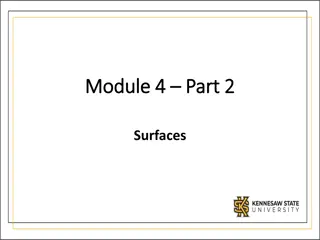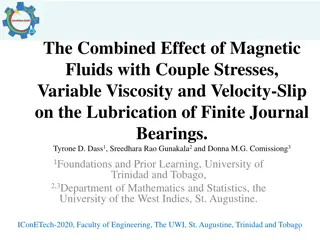Understanding Tribology: The Science of Interacting Surfaces
Tribology is the study of friction, lubrication, and wear of surfaces in relative motion. It plays a crucial role in various industrial applications, with economic significance and implications on failure rates in engineering systems. The discipline focuses on surface interactions, forces transmission, material response, and system design, addressing essential questions about friction, wear, lubrication, and surface conditions that influence these phenomena.
Download Presentation

Please find below an Image/Link to download the presentation.
The content on the website is provided AS IS for your information and personal use only. It may not be sold, licensed, or shared on other websites without obtaining consent from the author. Download presentation by click this link. If you encounter any issues during the download, it is possible that the publisher has removed the file from their server.
E N D
Presentation Transcript
MET377 Surface Engineering Tribology
What is tribology? Tribology is defined as the science and technology of interacting surfaces in relative motion, having its origin in the Greek word tribos meaning rubbing. It is a study of the friction, lubrication, and wear of engineering surfaces with a view to understanding surface interactions in detail and then prescribing improvements in given applications.
What is tribology? Economically very important -- 6% GDP(Jost) Probably more failures are caused by tribological problems than fracture, fatigue, plastic deformation, etc. Tribological problems are often related to systems issues.
Four Elements of Tribology Surface interactions with its environment, including lubrication and lubricants Generation and transmission of forces at the interface Response of materials to the force generated at the interface Design of tribological systems
Some of the Basic Questions What is friction? How is the friction force generated? What is the coefficient of friction? How do materials wear? What is the effect of the applied load on friction and wear? What is the role of lubricant? How do you lower friction? How should we reduce the wear rate of materials?
What is friction? Friction is a result of energy dissipation at the (sliding) interface. Friction is affected by the following: 1. Presence of wear particles and externally introduced particles at the sliding interface Relative hardness of the materials in contact Externally applied load and/or displacement Environmental conditions such as temperature and lubricants Surface topography Microstructure or morphology of materials Apparent contact area 2. 3. 4. 5. 6. 7.
Chemical and Physical State of the Solid Surface Atomic Arrangement of the Solid Surface (to lower the free energy of formation) (a) reconstruction, (b) segregation, (c) chemisorption, (d) formation of compounds, (e) physisorption, (f) nucleation of atoms on the surface (a) (b) (c) (d) Figure by MIT OCW. After Estrup, 1975.
General Characteristics of Metals 1. Metallic bonding 2. Structure -- fcc, bcc, hcp 3. Defects control mechanical properties. Dislocations Vacancies 4. Higher energy state at the surface -- Surface energy 5. Importance of microstructure 6. Alloys -- substitutional, interstitial, multiphase, dispersion strengthened, 7. Reactive -- oxides, carbides,intermetallics
General Characteristics of Polymers 1. 2. 3. 4. 5. Covalently bonded long chain molecules Thermoplastics, thermosets, elastomers, Linear polymers -- HDPE, PTFE Semicrystalline vs amorphous polymers Low melting point, glass transition temperature Difference in molecular weight at the surface and the bulk = f(nucleation conditions) 6.
General Characteristics of Ceramics 1. Mostly ionic bonding, some have covalent bonding Combination of metallic and nonmetallic elements Oxides and nitrides are very stable -- Low free energy of formation Carbides are very hard and have very high temperature Brittle Electrically non-conducting Abrasives 2. 3. 4. 5. 6. 7.
General Characteristics of Composites 1. 2. 3. 4. Typically resin + fibers or filler or both Fiber orientation important May be designed to achieve specific properties Used without lubricants
General Characteristics of a Solid Surface 1. 2. Surface energy Surface may be different from the bulk in atomic structure, mechanical properties, chemical state Wear resistance Corrosion resistance Hardness 3. 4. 5.
Lubrication Lubrication is the process or technique employed to reduce wear of one or both surfaces in close proximity, and moving relative to each another, by interposing a substance called lubricant between the surfaces to carry or to help carry the load (pressure generated) between the opposing surfaces. Role of lubricants 1. Change surface energy (monolayer) 2. Reduce metal to metal contact through wetting 3. Prevent particle agglomeration through wetting
Mechanical Properties of the Surface 1. Is the surface harder or softer than the bulk? 2. Does it matter? Oxide Metal
What is friction coefficient? 1 varies as a function of the sliding distance. 0.6 0.2 0 20 40 60 80 0 Distance slid( m)
Scale issues in tribology Scales in Tribology and TypicalValues Range of friction coefficient( ) & wear coefficient(k) Scale Applications =0.1~1 k =10-5~10-2 10-4m machinery brake,tools =0.001~0.2 k=10-7~10-5 10-6m lubrication roller bearing =0.01~0.6 k=10-8~10-5 10-8m head/ disk MEMS =0.001~0.6 k ~0 10-10m AFM lithography
Friction at Dry Sliding Interface Plowing Mechanism Particle Agglomeration Height of Agglomerated Particles Friction Coefficient and the Number of Agglomerated Particles Reduction of Friction by Elimination of Particles
Effect of Boundary Lubrication ~ 0.1 Cause? Plowing What is the role of a lubricant? Lower shear stress Transportparticles Prevent particle agglomeration Prevent adhesion
Introduction to Wear Plastic deformation at the interface often leads to wear, i.e., deformation induced wear. Wear can also be caused by chemical processes. There are many different kinds of wear mechanisms The process leading to loss of material is known as "wear Types of wear Adhesive wear Abrasive wear Surface fatigue Fretting wear
Adhesive wear Adhesive wear are caused by relative motion, "direct contact" and plastic deformation which create wear debris and material transfer from one surface to another. Example of Adhesive Wear: Chalk on board-while writing
Abrasive Wear Abrasive wear occurs when a hard rough surface slides across a softer surface. ASTM International (formerly American Society for Testing and Materials) defines it as the loss of material due to hard particles or hard protuberances that are forced against and move along a solid surface.
Types of Abrasive wear Abrasive wear is commonly classified according to the type of contact and the contact environment The two modes of abrasive wear are known as two-body and three-body abrasive wear Two-body wear occurs when the grits or hard particles remove material from the opposite surface. Three-body wear occurs when the particles are not constrained, and are free to roll and slide down a surface. Two-body wear Three-body wear
Erosive Wear Erosive wear can be described as an extremely short sliding motion and is executed within a short time interval. Erosive wear is caused by the impact of particles of solid or liquid against the surface of an object.
Fretting wear Fretting is the repeated cyclical rubbing between two surfaces, which is known as fretting, over a period of time which will remove material from one or both surfaces in contact
Wear Mechanisms Classification WearMechanisms Wear coefficient K(range) 10-4 10-4 10-4 10-4 10-2to10-1 10 -6 to10-4 Wear dominated by mechanical Behavior ofMaterials 1.Asperity deformation and removal 2.Wearcausedby plowing 3.Delaminationwear 4.Adhesive wear 5.Abrasivewear 6.Frettingwear 7.Wear by solid pa rticleimpingement 1.Solut ionwear 2.Oxidat ionwear 3. Diffusionwear 4.Wearbymelting ofthesurfacelayer 5.Adhesive wear at high temperatures Wear dominated by chemical behavior of materials
Friction and Wear of Polymers and Composites Why do we use polymeric bearings? Low friction No need to lubricate Bio-compatible Ease of manufacturing Low noise Low cost
Applications of Polymeric Bearings Industrial applications Gears Ball bearing cages Journal bearings Sliders Cams Seals for shafts, etc. Tribological Applications of Polymeric Bearings in Medicine and Related Areas Bio-medical applications Valves Hip joints Knee joints Pump components
Common Plastics Used in Tribology Thermoplastics (with and without fibers) polyethylene (PE) Ultra-high molecular weight PE Polyoxymethylene (POM, acetal) -- Delrin Polytetrafluoroethylene (PTFE) Polyamide(nylon) Polycarbonate
Common Plastics Used in Tribology Thermosetting plastics (with and without fibers) polyurethane phenolics polyester phenolics polyimide
Common Plastics Used in Tribology Elastomers (reinforced with carbon or fibers) silicone rubber -- medical applications natural rubber polybutadiene rubber -- tires nitrile rubber -- good resistance to oil
Highly Linear Polymers PTFE Highly linear Relatively weak inter-molecular force Easy transfer of molecules to the counter face Consequently -- low =0.09
Friction and Wear Mechanisms of PTFE Process 1. Deformation of molecules near the surface due to the applied force at the surface 2. Stretching of molecules, orienting them along the sliding direction 3. Transfer of thin films of 50 to 200 Athick 4. Sliding of PTFE on PTFE
Friction and Wear Mechanisms of Other Ductile Thermoplastics (LDPE, PP, PMMA) LDPE (Low-density polyethylene) and PP (ductile) Wear particles are thick and lumpy debris Less elongation PMMA(Poly(methyl methacrylate)) (brittle) Cracks can develop at the surface
Basic Mechanism of Friction in Polymers Viscoelastic-plastic deformation at the sliding interface Plowing Asperity deformation Wear particle deformation
Conclusions 1. Friction is a manifestation of the energy consumed when two surfaces in contact slide relative to each other -- with and without the normal load. 2. Friction is caused by plowing, adhesion and asperity removal. 3. In a majority of engineering applications that involve a metal surface sliding against another, the friction force is generated by plowing of the surfaces by wear particles. The friction force is also generated by the work done to shear asperities and in some rare cases, by the adhesion between the two contacting surfaces.
Conclusions 4. Friction is not an inherent material property. It depends on the relative hardness of materials that are sliding against each other. The friction is the highest when the two surfaces have exactly the same hardness. 5. Removal of wear particles by the use of undulated surface reduces the coefficient of friction to a level of boundary lubricated cases with boundary lubricants. 6. Boundary lubricants lower the friction coefficient by preventing wear particle agglomeration and plowing, but still there is a metal-to-metal contact, which leads to plowing and the observed coefficient of friction of about 0.1.
Conclusions 7. Polymers are used extensively in diverse applications because of their unique tribological properties. For instance, highly linear polymers have low coefficients of friction. 8. Composites can be made with polymeric materials and fibers or fillers to satisfy a specific set of functional requirements.
Questions for self-assessment Chapter 2 1. How can performance of an engineering component be related with service life? 2. Describe common causes of deterioration in performance of material. 3. What are the common types of wear experienced by metals? 4. Explain the mechanisms of adhesive wear. 5. Describe factors affecting adhesive wear. 6. How do service conditions affect the adhesive wear? 7. Explain classical law of adhesive wear. 8. What is abrasive wear? Describe mechanisms of abrasive wear. 9. Explain the factors affecting abrasive wear of metals. 10. How do material properties affect the erosive wear? 11. Explain mechanism of erosive wear. 12. Describe the factors affecting erosive wear of metals.























